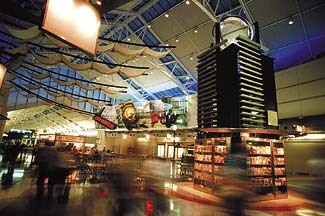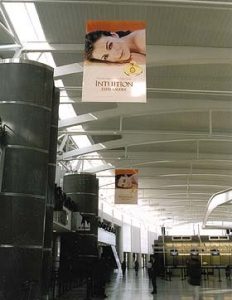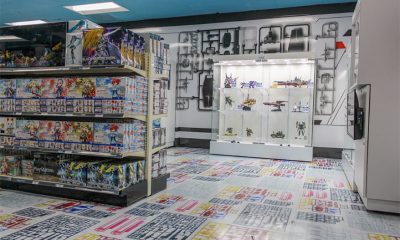Banners + Awnings
Come Fly with Me
A look at the many faces of signage in the ever-expanding world of airports
Published
18 years agoon

Airports are no longer just places where travelers arrive, depart or wade through a sea of humanity in search of their connecting flights. Many airport authorities seek a certain "look" for their terminals in hopes of presenting a certain image of vibrancy and limitless possibilities to the world touching down at their doorsteps.
Graphic designers and sign fabricators play an integral role in creating airports that buck the old school of cookie-cutter airport designs. Airport terminals are expanding to accommodate the exponential growth of air travel, and airport officials overseeing this boom cultivate an identity for their respective cities.
Wayfinding components also serve vital purposes in an airport's environmental design. While they may not be the "sizzle" of an airport's signage program, they serve as an airport's nervous system, pointing the way for harried and time-strapped travelers. Interior and exterior advertising displays increasingly cover airport landscapes. And while signs on runways and taxiways may not be of particular interest to travelers, they ensure safety on the runways.
Sin City's welcome mat
T. Wayne Hunt, principal designer for Hunt and Assoc. (Pasadena, CA) has overseen his firm's design of the expansion of Las Vegas' McCarran International Airport, which ranked as the nation's 10th-busiest airport in 1999. Working in tandem with architects Tate and Snyder on the $200 million project, Hunt created a design scheme that features upgraded wayfinding and a new retail gaming area with signage and identity graphics.
"Airport graphics are pretty straightforward," he explains. "Processing information is the main activity, and clear signage is desired, unlike most other environments."
AdvertisementTwenty-six of McCarran's gates were completed in 1998. Thirteen more will be completed later this year, with the remaining 13 gates slated for renovation within the next few years.
Current trends encourage better retail options and food choices, and provide potentially colorful signs and graphics, a departure from previous trends, Hunt says.
"It's vital that airports target the right demographic," Hunt says. "What I call the humanizing of airport environments makes travelers seem more at home. Airports are a gateway that provides an important first impression for visitors."
The concourse's crowning glory is the Airstrip, a retail and gaming area that offers visitors a taste of what the city has to offer. Hunt established the airport's design criteria, dictating that retail tenants "Vegasize" their presence. A dimensional cabinet sign with a propeller advertises a dinette. A Cinnabon nestled amidst the slot machines advertises with a gargantuan fiberglass cup with "steam" rising above its lip. This is not your neighborhood mall's distributor of gooey, fat-packed confections.
Hunt's design team even had some fun with the airport's ancillary signage. The smoker's lounge and children's play feature exposed neon signage. Billowy white tubes overhead impart the effect of a smoky lounge.
"Only in Las Vegas," Hunt jokes. "Bright lights and neon are so vital to that city's culture that you can go over the top a little bit."
AdvertisementHunt and Assoc. is in final negotiations to renovate San Diego's airport, with work starting later this year if a deal is struck.
Pointing the way
Wayfinding, the unsung hero of airport signage, serves the most visceral aspects of signage — telling someone where to go, warning them of off-limits or dangerous areas, and giving notification of any actions prohibited on airport premises.
Jan Carpman, senior partner with Carpman Grant Assoc., an Ann Arbor, MI-based wayfinding consultancy, underscores the vital elements of wayfinding.
"The mission of wayfinding, telling people where to go and how to get there, seems extremely simple," she explains. "But it's astounding how many sites, including airports, fail to live up to this mission. The results of poor wayfinding are stressed, annoyed and unhappy travelers."
In Düsseldorf, Germany's airport, questionable wayfinding played a role in a far worse fate. On April 11, 1996, fire broke out in the terminal, which became rapidly engulfed in smoke. Travelers had difficulty finding the exits, and 17 people perished in the disaster.
AdvertisementThe Düsseldorf fire brigade specifically cited victims' inability to read the exit signs as the culprit for the high rate of casualties. Since the tragedy, airport officials have ensured that user-friendly wayfinding is in place.
The Las Vegas airport's renovation will feature more prominent, larger wayfinding signage. With some twists, according to Hunt.
"We have a unique challenge at McCarran in that the terminal has an underground rail system that enters the property below the airport. Strong wayfinding is required to get passengers from the rail system to the terminal above ground. We have established criteria that call for the prominent use of color, assisting the traveler as much as possible."
With all public places, areas must include proper ADA signage. Effective use of space is key to accommodating such special needs.
"Airports are among the simpler destinations for which to create ADA signage," Hunt explains. "There are only so many destinations, and airports are generally large, open spaces."
On the taxiways and tarmacs of airports, wayfinding signs of a different sort direct the flow of airplanes touching down and taking off. These signs are stringently regulated by the Federal Aviation Administration (FAA), with rules ranging from wind-load tolerances to the heights of letters and numerals.
Cleveland-based Standard Sign Co. has fabricated airport signage since 1955, when the FAA first established sign specifications. Vice President Mark Messner notes that runway signage experienced a boom back in 1993, when revised FAA standards mandated new runway signage, therefore tripling demand. Since then, demand for signs has been fairly constant, Messner said.
One of the signs' main purposes is the prevention of ground intrusion, he said.
"It's always a concern that a ground vehicle is going to get in the way of a plane trying to take off or touch down," Messner explains. "Without the appropriate signage, an inexperienced driver of such a vehicle could make a mistake, getting in the way of an aircraft and causing real problems."
Terminal advertising
No different than the rest of the world, the long arm of advertising grabs airports. The top 50 U.S. airports greeted roughly 1.2 billion visitors in 1999, according to statistics from the Airport International Council. Thus, they present an appetizing market of general affluence to retailers and service providers.
JCDecaux SkySites, a New York-based subsidiary of the JCDecaux Out of Home Media Group, handles advertising concessions in 53 American airports and 135 worldwide. The firm's airport advertising revenue has risen from $37 million in 1998 to a projected $80 million for 2000, according to company spokeswoman Danya Gerstein.
Steve MacKelvie, the firm's vice president of business development, says that airport concessions are approved by airport authorities based on proposals submitted by firms to install, sell and maintain airport advertising concessions. Contracts typically span 5-7 years.
Hung on aeronautical wire, the firm's hanging banners are two-sided opaque vinyl, measuring 12 x 8 ft. Wraps consist of digitally printed 3M Industrial Adhesives & Tapes Div. Scotchprint™, with a lifespan of up to one year. Some of the company's other products include freestanding displays, plasma touchscreens and external electric signage.3M Industrial Adhesives & Tapes Div.
An airport "happy hour"
Mark Artus, executive vice president of Fitch/AAD Design (Columbus, OH), likes the tone of airport design heading into the 21st century.
"I think it is marvelous that those directing airport authorities around the country and around the world are getting away from the same-old, same-old in airport design," Artus says. "Airport travelers tend to be educated, affluent people, and it seems like those designing and conceptualizing airports are only recently beginning to appeal to this type of traveler."
Artus explained that the firm performed a study on stress levels of airline passengers. According to the study, passengers have a "happy hour," when they are assured that they know there are no problems with the logistics of their travel. The ideal is to reach would-be customers during this period, Artus said.
The company's Phoenix office created a festive environment for the Jose Cuervo Tequileria restaurant at the Phoenix Sky Harbor International Airport, which was completed in March 2000. Against a backdrop of Fitch-designed tables (designed with Cuervo catchphrases like "Lick, shoot, suck" and "Did I hear someone say Conga line?"), cheerfully colored chairs and a neon-illuminated tile mosaic lizard, the firm created a signage program that virtually grabs passers-by.
The entrance sign to the Tequileria is canvas, with acrylic push-through letters, according to Carl Schaffer, partner with Fitch/AAD. Adapting a new logo from Jose Cuervo's traditional trademark, several pin-mounted Sintra® expanded signs adorn the walls, while Mexican tin starlights hang over the bar, enhancing the signage. Local muralists Ed Hirth and Eddie Van Liu painted the walls with Cuervo's signature "party animals."
"I am very pleased with the way the identity program has turned out," Schaffer says. "This is a very lively place that presents an air of authenticity."
Joe Campbell, assistant general manager with HMS Host, the Bethesda, MD-based company that operates the Tequileria and approximately 70 other airport restaurants, relishes the environment the establishment provides for the airport.
"The feedback has been overwhelmingly positive," Campbell said. "Not only because of its authentic environment, but because it makes customers and staff almost forget that they are in an airport, but rather gives the perception that they are at a restaurant on the street."
Welcome to the neighborhood
Mayer/Reed (Portland, OR) captured the essence of the "City of Roses" with the creation of a giant multi-dimensional mural that graces the walls of a two-phase upgrade of Concourse C at Portland, OR International Airport. Portland officials wanted to bring a vibrant look to their city, fast becoming one of the Pacific Northwest's popular destinations.
Michael Reed, the firm's principal and project director, said that the airport's murals "instill a sense of connection to our locale and our region, thus creating comfortable gathering places with local vendors, not unlike the grand halls of old train depots. The city wanted us to carve out an environment that could be something more than a 'hold room,' bringing continuity to the theme of an Oregon market."
Designed by MayerReed's Glen Marcusen, the mural, completed early last year, depicts vintage signs from Portland's neighborhoods and business districts. The 50 x 25-ft. eye-catching mural comprises eight suspended translucent panels with Scotchprint digital images. The mural captivates viewers with a fiberoptic rendition of a babbling fountain (a tribute to Portland's abundance of fountains) and a backwards-ticking clock framed in exposed neon, among other scenes of Portland's bygone era. The murals are enhanced by white, cloud-like overhead banners and natural backlighting from solar panels. A fiberglass globe perched atop a 30-ft. tower further enhances the environment.
Later this year, the firm will complete a plasma-screen display for the airport's baggage-claim area. Also in the works are sign-design programs for the light-rail system that will soon service the Portland airport. MayerReed will also redesign the airport's D concourse, complete with a glass and metal tower supporting a 16-monitor, plasma-screen display system, as well as enhanced retail areas.

SPONSORED VIDEO
Introducing the Sign Industry Podcast
The Sign Industry Podcast is a platform for every sign person out there — from the old-timers who bent neon and hand-lettered boats to those venturing into new technologies — we want to get their stories out for everyone to hear. Come join us and listen to stories, learn tricks or techniques, and get insights of what’s to come. We are the world’s second oldest profession. The folks who started the world’s oldest profession needed a sign.
You may like

NUtec Digital Ink Invests in Solar Energy for Facility

5 Reasons to Sell a Sign Company Plus 6 Options

21 Larry Albright Plasma Globes, Crackle Tubes and More
Subscribe

Bulletins
Get the most important news and business ideas from Signs of the Times magazine's news bulletin.
Most Popular
-

 Tip Sheet1 week ago
Tip Sheet1 week agoAlways Brand Yourself and Wear Fewer Hats — Two of April’s Sign Tips
-

 Photo Gallery3 days ago
Photo Gallery3 days ago30 Snapshots of the 2024 ISA Sign Expo
-

 Ask Signs of the Times5 days ago
Ask Signs of the Times5 days agoWhy Are Signs from Canva so Overloaded and Similar?
-

 Real Deal2 weeks ago
Real Deal2 weeks agoA Woman Sign Company Owner Confronts a Sexist Wholesaler
-

 Benchmarks1 week ago
Benchmarks1 week ago6 Sports Venue Signs Deserving a Standing Ovation
-

 Photo Gallery9 hours ago
Photo Gallery9 hours ago21 Larry Albright Plasma Globes, Crackle Tubes and More
-

 Women in Signs2 weeks ago
Women in Signs2 weeks ago2024 Women in Signs: Megan Bradley
-

 Women in Signs1 week ago
Women in Signs1 week ago2024 Women in Signs: Ashley Borell












